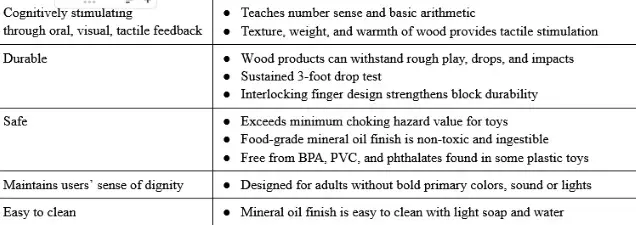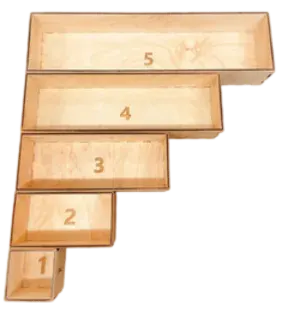Hey goobers! This post will be about my final project for the 1st quarter of a 2 quarter sequence at Northwestern known as Design Thinking and Communciation (DTC). Here’s my final project for the second quarter of the sequence: Safesplash.
My group members (Burke Stanton, Jonas Goldberg, Lucas Holliday), and I designed Nesting Number Blocks, a set of mathematics manipulatives for adults with intellectual and developmental disabilities at Misericordia Home. This was prepared for Nicole Humphrey, a teacher at Misericordia, who now uses our product in her classrooms.
Table of Contents
Open Table of Contents
- Final Poster
- Executive Summary
- Introduction
- Design Concept
- Future Development
- Accomplishment!
- References
- Appendices
- Appendix A: Project Definition
- Appendix B: Background Research
- Appendix C: Project Partner Interview Summary
- Appendix D: User Observations Summary
- Appendix E: Design Review / Expert Interview Summary
- Appendix F: Dimensional Orthographic View
- Appendix G: Instructions for
- Appendix H: Bill of Materials
- Appendix I: Instructions for Use
- Appendix J: Project Partner Prototype Feedback
Final Poster
For those who don’t wanna read this monster post, I don’t blame you:
Executive Summary
Problem Statement
Adults with intellectual and developmental disabilities at Misericordia do not have access to age-appropriate math manipulatives in the classroom to provide cognitive stimulation while meeting their sensory profiles and maintaining their dignity and safety.
Research Methodology
An interview with the project partner was conducted over Zoom on September 25, 2023 to understand how existing products fail to meet users’ needs. On October 9, 2023, the team observed three Misericordia residents, __, __, and __. Because Matthew demonstrated his ability to differentiate a number from a letter, he was selected as the target user for the design. After brainstorming solutions, four ideas were then prototyped and presented to the project partner for feedback on October 24, 2023.
Design Concept and Rationale
The Number Nesting Blocks are large and durable manipulatives representing numbers one to five to teach number sense and basic arithmetic. Since each higher numbered block is larger than the previous number, smaller blocks fit inside larger blocks.


Future Research, Testing and Development
Since the project partner indicated that blocks one through nine would be helpful in teaching basic addition and subtraction, a future iteration could feature blocks in smaller sizes. In the current design, blocks greater than six units become unwieldy. It might also be interesting to explore multiple dimensions by designing unit blocks that expand in both length and width. Additional user testing with both residents and teachers at Misericordia is also recommended.
Introduction
Matthew proudly points to the number “8”, demonstrating that he has mastered the skill of learning numbers and letters. Residents at Misericordia, a community of care for persons with mild to profound intellectual and developmental disabilities (IDD), enjoy cognitive stimulation and want to learn. However most educational products currently on the market are designed for children. There is a gap in large and sturdy manipulatives to teach number sense and basic arithmetic to adults with IDDs, which encompass hundreds of diagnoses including autism, pica, and sensory processing disorders. This population desires durable products that effectively educate and engage them through oral, visual, or tactile feedback based on their sensory profiles, while maintaining their sense of dignity and safety (see Appendix A for Project Definition).
Autism is a neurodevelopmental condition characterized by neurocognitive impairment, poorly developed social skills, difficulty with expressive and receptive communication, and the presence of repetitive behaviors (see Appendix B for Background Research). For people with IDDs, chewing feels good, provides sensory stimulation, alleviates discomfort, relieves stress, anxiety and boredom, and allows an escape from sensory overload. Oral stimming, a series of repetitive chewing behaviors, is an automatic and uncontrollable reaction. A pica diagnosis is characterized by a pattern of eating or mouthing inedible materials such as stones, dirt, soil, grass, metal or feces. Gross motor problems and difficulties with fine motor control, low muscle tone leading to poor posture or balance, or challenges with hand-eye coordination can range from mild to severe. The target user is a resident at Misericordia with severe or profound IDD who exhibits autistic and/or pica behaviors (see Appendix C for Project Partner Interview Summary).
Since there are few products on the market specifically designed for adults with IDDs, most are forced to engage with toys designed for babies and children (see Appendix D for User Observations Summary). Many of these toys, made with bright primary colors and childish designs, draw unwanted attention, negatively impacting their self-esteem and sense of dignity. For example, soft pillows to practice zippers, buckles, or shoelaces are often stuffed animals. LED light-up toys with loud sounds are overstimulating and draw unwanted attention. On the other hand, products designed for adults often have small parts that present choking hazards.
The Nesting Number Blocks, large and sturdy manipulatives to teach the concept of equality and addition, are designed to be cognitively stimulating for adults with IDDs. The design features blocks with open tops, physically representing numbers one through five. The blocks represent each number quantity relatively using relative size. Since a block corresponding to a higher number is larger than the previous numbers, smaller blocks fit inside larger blocks. This allows the user to manipulate the blocks to learn that if the 2-unit block and the 3-unit block fits into the 5-unit block, then 2 > 3 > 5 and 2 + 3 = 5. The blocks meet safety standards by not becoming a choking hazard if chewed or bitten or if broken when dropped or thrown. Constructed of natural wood, the blocks do not draw unwanted or negative attention, preserving users’ sense of dignity.
This report also explains the design requirements and rationale for the Nesting Number Blocks and ideas for future development. Instructions for construction and use are also included.
Design Concept
Manipulatives are considered essential in teaching mathematics. Research has found that long-term use of manipulatives has a positive effect on student achievement by allowing students to use concrete objects to observe, model, and internalize abstract concepts. Based on an interview with Michele Ricamato, a licensed speech language pathologist for children with special needs, the team learned that humans first subitize quantities one to five. Subitizing is defined as instantly recognizing the number of objects observed without actually counting them.
The Nesting Number Blocks physically represent the numbers one to five, where each block represents each number quantity relatively using relative size. Each block has its corresponding number engraved on all sides to teach that a symbol represents quantity and to aid with visual identification.

Based on feedback from Michele Ricamato, the wood was not painted to avoid the user associating number value with color.
The product represents each number quantity identically, such that all 1-unit blocks are the same size and shape. A detailed dimensional drawing of the orthographic view of the 1-unit block (a 4-inch cube) can be found in Appendix F. Instructions for Construction are included in Appendix G and the Bill of Materials can be found in Appendix H.
The first step in introducing the concept of counting and numbers is one-to-one correspondence. One-to-one correspondence is the ability to count while pointing to one object at a time. The image below illustrates how the Number Nesting Blocks can be used to master one-to-one correspondence with 1-unit cubes.

Since lower numbered blocks are slightly smaller in size than higher numbered blocks, these blocks can be placed inside higher numbered blocks (see Appendix I for Instructions for Use). The 3-unit block and the 2-unit block can be physically placed into the 5-unit block. With teacher scaffolding or user trial-and-error, the blocks help the user learn that 2 > 3 > 5 and 2 + 3 = 5 (see below).

The Nesting Number Blocks meet all of the design requirements (see overall requirements in Appendix A: Project Definition).
Cognitively and Intellectually Stimulating
The Nesting Number Blocks provide intellectual stimulation by teaching number sense through the concepts of equality and simple addition. Based on the way that developing brains come to understand equality and relative value of numbers, blocks of equal value are designed to be of equal size, and blocks of relative values are designed with relative size. This helps learners connect the ideas of size and value. The blocks represent the range of numbers one to five because developing brains are more capable of subitizing, or immediately recognizing the quantities of objects without counting numbers in that range (see Appendix E for Design Review/Expert Interview Summary).
Sensorially Stimulating (through oral, visual, or tactile feedback)
According to our project partner, it is important to avoid overstimulation of more than three senses. Thus, the blocks are designed without a scent, noise, bright lights, or spiky or multiple textures (see Appendix C for Project Partner Interview Summary). The texture, weight, and warmth of wood also provides tactile stimulation. The mineral oil finish increases sensory appeal by adding volume to the grain and enhancing the natural color and aesthetics of the wood.
Durable
Since objects can be accidentally or intentionally dropped or thrown as an attention-seeking behavior, the wood blocks are not easily broken and do not present a choking hazard if chipped. Wood products can withstand rough play, drops, and impacts. Each block side is designed with fingers that tightly interlock with each other and are then glued, increasing the product’s resilience to breaking. The mineral oil finish protects the wood against changes in humidity, making the blocks less susceptible to cracking or warping. In an experimental testing scenario, a wood block was dropped from a height of 3-feet. The product successfully sustained the drop without any negative consequences.
Safe
The Nesting Number Blocks are designed without parts that could present a choking hazard. Misericordia staff need to trust that if they leave the room, the resident is safe with the product without supervision (see Appendix I for Project Partner Prototype Feedback). Based on guidelines from the Consumer Product Safety Commission, small parts on toys must be greater than 2.25 inches in width and greater than 1.25 inches in length (see Appendix A for Project Definition). The smallest 1-unit block is a 4-inch cube, exceeding the minimum value as a choking hazard.
The blocks are constructed out of wood, a material free from harmful chemicals such as BPA, PVC, and phthalates which can be found in some plastic toys. Plastic products, especially ones manufactured cheaply, can also break easily, potentially leaving sharp edges and small parts. The blocks are finished with mineral oil, a non-toxic and odorless substance, used to protect butcher blocks from drying out. This food-grade mineral oil is safe to ingest. Lastly, as a renewable resource, wood is more environmentally sustainable and degrades over time if the blocks end up in a landfill.
Maintains Sense of Dignity
Because adults with IDD are often made fun of and marginalized, the product should not draw unwanted attention. The Number Nesting Blocks are constructed of natural wood and are not painted in the bold, primary colors with cute designs often associated with toys designed for babies or young children. In addition, the blocks do not include sound, bright or flashing lights, or a strong scent.
Easy to Clean
Since the Number Nesting Blocks may be dropped onto the floor either accidentally or intentionally, the mineral oil finish ensures that the blocks are easy to clean with light soap and water or with other cleaning materials already present at Misericordia. Since frequent cleaning with water will dry out the wood, the mineral oil should occasionally be reapplied with a soft cloth. Another sanitizing alternative to reduce time involved in wiping down every block is to add equal parts water and vinegar to a spray bottle. The blocks should be sprayed with this vinegar-water solution and dried completely, ideally overnight.
Engages the Learner
The blocks provide a teaching tool to engage the user to learn number sense and simple arithmetic. Users will feel a sense of accomplishment and be more likely to take responsibility for their learning after successfully fitting smaller unit blocks into larger unit blocks through independent trial-and-error or through teacher scaffolding. According to our project partner, “Getting a smile out of someone who doesn’t often [smile] is a great day” (see Appendix C for Project Partner Interview Summary).
Future Development
Given time constraints and logistics, Matthew, the target user, did not participate in testing. Future development should involve testing the Nesting Number Blocks with the target user and other adults with intellectual and developmental disabilities in the classroom environment - both in free play and with teacher scaffolding the instruction of math concepts.
The blocks could be improved by considering another tool for fabrication since the laser cutting imparts a strong and long-lasting scent, although some users may find the scent appealing. If users still find the scent overly stimulating or distracting even after the application of mineral oil, an alternative method of cutting could be considered during construction.
The current design includes unit number blocks one through five. However, the project partner indicated that blocks one through nine would be helpful in teaching basic addition and subtraction (see Appendix E for Project Partner Feedback Summary). Since a unit block measures 4 inches in width, length and height, the 5-unit block is almost 2-feet long. Thus, higher numbered blocks could become unwieldy to manipulate. A future iteration could involve smaller sized blocks while still allowing adults with poor fine motor skills to manipulate and nest them within each other. It might also be interesting to explore the design of blocks in multiple dimensions, for example, designing unit blocks that expand in both length and width.
Accomplishment!
The Nesting Number Blocks allows adults with IDDs to explore mathematical concepts of equality and basic arithmetic. Access to a concrete object that meets the user’s age, developmental level, and sensory needs is vital for grasping the first stage of developing abstract mathematical understanding. Residents at Misericordia can learn equality and addition either through trial-and-error by exploring the blocks on their own or with the help of teacher instruction in the classroom, while providing both visual and tactile stimulation. Since the blocks are large (the 1-unit block is a 4-inch cube), users will receive immediate feedback if they attempt to nest a larger block inside a smaller block. Constructed of wood and finished with a nontoxic, natural mineral oil, the Nesting Number Blocks appeal to the senses. The wood blocks do not present a choking hazard and are not easily broken. Designed for adults, the product does not draw unwanted attention and preserves the users’ sense of dignity.
References
“About Us,” Misericordia. Web. https://www.misericordia.com/about/
“Advantages of Wooden Toys Over Plastic Toys,” Oribel, August 2, 2019, https://www.loveoribel.com/blogs/oribel-blog/the-advantages-of-wooden-toys-over-plastic-toys
Barkley, S., “What’s the Link Between Autism and Oral Fixation?” Psych Central, February 21, 2023, https://psychcentral.com/autism/oral-fixation-autism
Fournier, C., “How Jean Piaget’s Theories Underpin Math Mastery,” Maths No Problem! September 15, 2022, https://mathsnoproblem.com/
Furner, J.M. and N.L.Worrell, “The Importance of Using Manipulatives in Teaching Math Today,” Transformations, Vol. 3, 2017. https://nsuworks.nova.edu/transformations/vol3/iss1/2
Krasa, N., K. Tzanetopoulos, and C. Maas, How Children Learn Math. Routledge.
“Learning to Count,” Montessori in Real Life, June 9, 2020, https://www.montessoriinreallife.com/home/2020/6/9/learning-to-count
Pagoria, N., “Pica - The Basics for Caregivers,” Advocate Health Care. https://www.advocatehealth.com/assets/documents/subsites/luth/downsyndrome/pica.pdf “Standard Consumer Safety Specification for Toy Safety,” United States Consumer Product Safety Commission, https://law.resource.org/pub/us/cfr/ibr/003/astm.f963.2011.html “Strategies to Provide Scaffolding When Teaching Mathematical Concepts, NZ Maths, https://nzmaths.co.nz/strategies-provide-scaffolding-when-teaching-mathematical-concepts
“What is Autism,” Autism Speaks. Web. https://www.autismspeaks.org/what-autism
“Why Teach Mathematics with Manipulatives?” hand2mind, https://www.hand2mind.com/resources/why-teach-math-with-manipulatives
“Why Wood is the Safest Choice for Montessori Toys: Exploring Safety and Durability,” Erenjoy, May 24, 2023, https://erenjoy.com/blogs/montessori-toys/